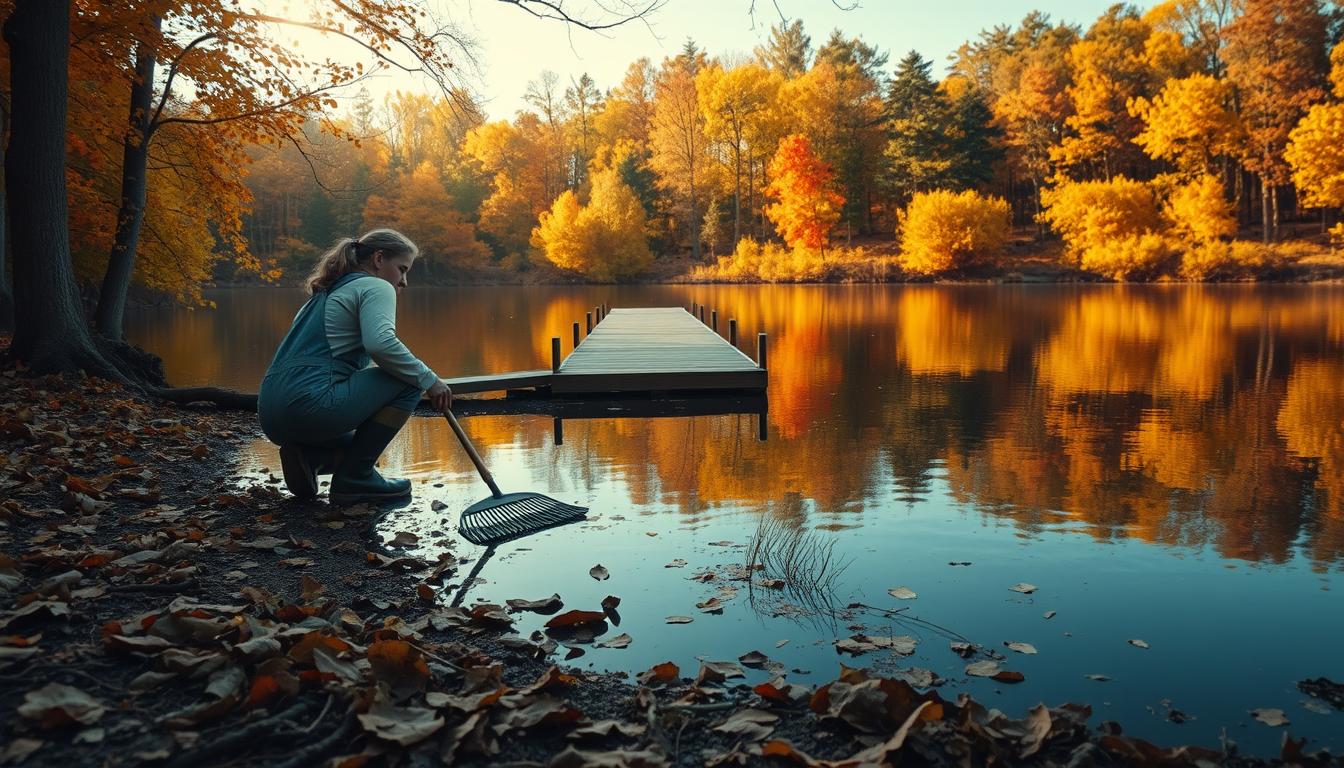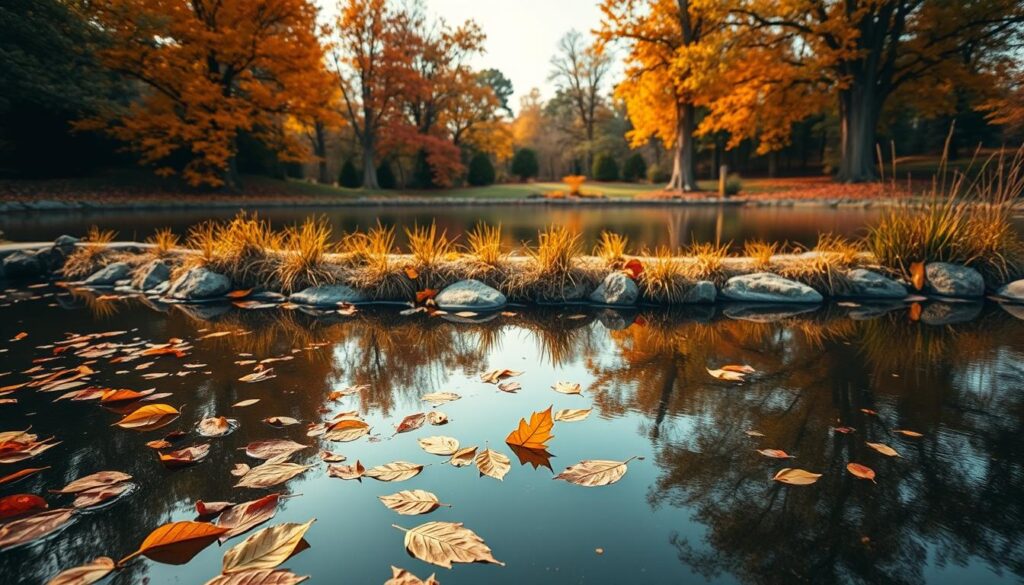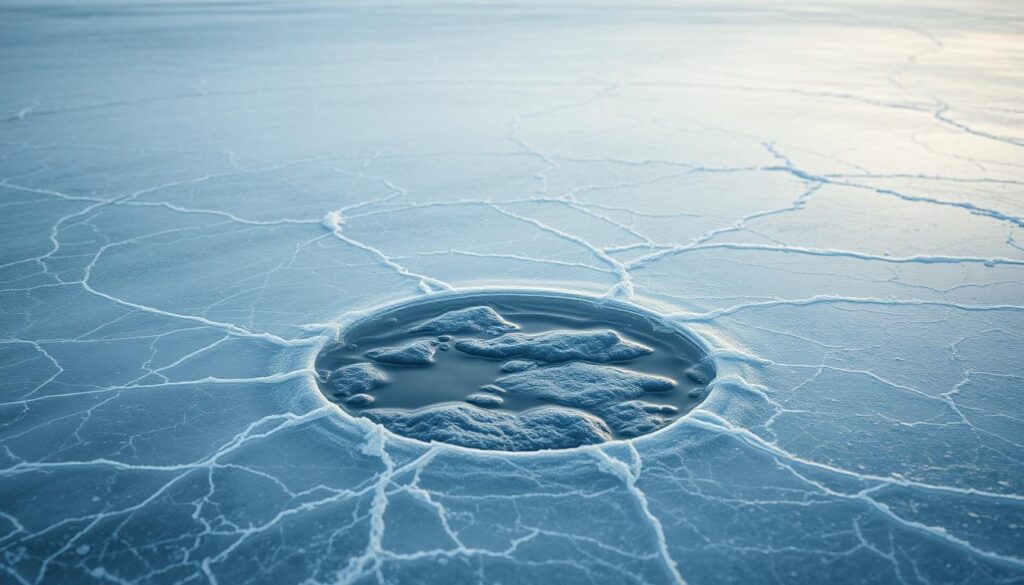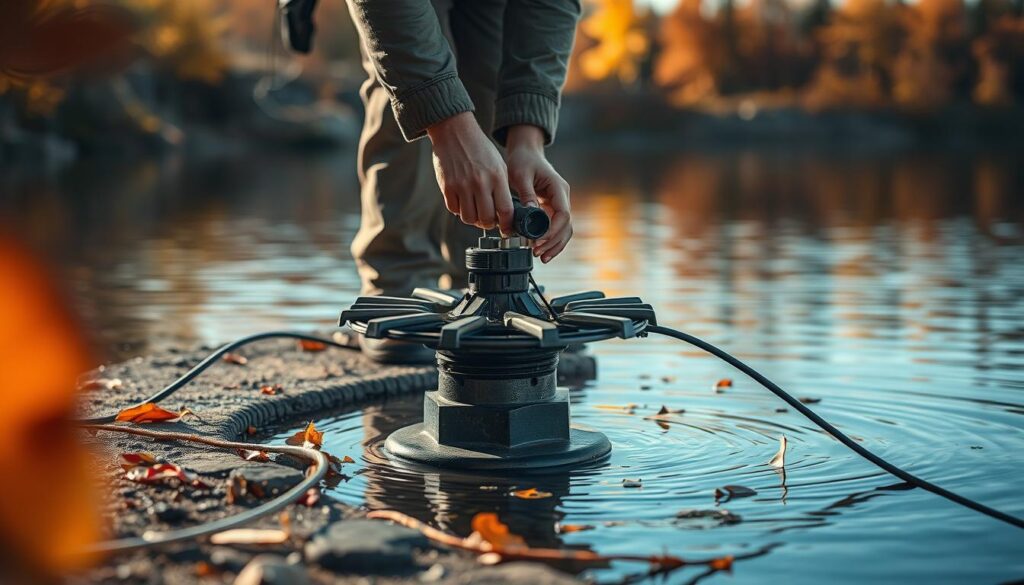
Prepare your backyard water feature for the colder months with a clear, step-by-step plan. Over the year, leaves, twigs, grass clippings, and fish waste build up and can decay, releasing gases and lowering oxygen. Proper pond maintenance reduces those risks and protects fish health.
This guide shows when and how to remove pond netting, shut down pumps, drain plumbing, clean filters and UV clarifiers, and store equipment safely. You’ll learn to trim hardy plants, move potted varieties to the bottom, and decide which tropicals to remove or overwinter.
Timing matters: schedule tasks around local leaf drop, use a hand net or pond vacuum to remove debris, and install aeration or a de-icer to keep a hole in ice. Switch to wheatgerm fish food as water cools, reduce feedings near 50°F, and stop below 40°F. Apply cold-weather bacteria while temperatures stay between 35°F and 60°F to aid organic breakdown.
Key Takeaways
- Clean debris early to prevent oxygen loss and toxic gases.
- Shut down and store pumps, filters, and UV units properly.
- Use aeration or a de-icer to maintain gas exchange through winter.
- Adjust feeding—switch to wheatgerm and stop under 40°F.
- Trim or relocate plants and consider overwintering sensitive species indoors.
- Deploy seasonal bacteria appropriately to aid decomposition.
Understanding Fall Pond Dynamics and Why Timing Matters
As days shorten and water temperatures fall, the biology that keeps a pond healthy slows. Beneficial bacteria that break down debris lose efficiency—about 30% at 47–54°F (8–12°C) and roughly 60% at 40–46°F (4–7°C).
How dropping water temperatures slow beneficial bacteria
Microbial cleanup is temperature sensitive. When temperatures dip, microbes digest organic waste more slowly just as leaves and runoff increase nutrient loads. That mismatch leads to bottom sludge and higher algae risk in spring.
Shorter daylight and oxygen demand in your backyard pond
Shorter days cut photosynthesis, so plants add less oxygen to the system. Coupled with extra nutrients and fish waste, oxygen demand rises.
- Act early: start cleanup before water temperatures drop and bacterial activity slows.
- Support oxygen: keep aerator and fountain intakes clear so equipment can offset deficits into winter.
- Local cues: match tasks to leaf fall and local temperature trends to protect pond water and fish into spring.
Safety, Readiness, and Tools You’ll Need
Before any work begins, set up a safe zone and gather tools. That simple step saves time and reduces risk when you access cold water and equipment during service months.
Stay dry and safe: waders, aqua gloves, and basics
Dress for safety and warmth. Use chest waders and long aqua gloves so you can reach into cold water without getting soaked.
Work from stable footing and plug tools into a GFCI-protected outlet. Label cords and hoses as you disconnect them to speed reassembly.
Cleanup and storage essentials: nets, pruning tools, pumps, buckets
Stage gear in advance: a submersible pump with a drain hose, sturdy nets, pruning shears, and a large bucket make cleanup faster.
- Keep a soft cloth and white vinegar or descaler handy for cleaning UV quartz sleeves safely.
- Use a pond vacuum to pull settled organics where nets can’t reach.
- Rinse and bag filter media, then store filters and in-pond pumps in a non-freezing space—ideally submerged in a bucket of water to protect seals over winter.
Final note: a quick check of tools and a staged plan reduces time outdoors and helps your backyard system return to service smoothly in spring. Proper readiness equals better pond care.
Fall Pond Prep
Start with a clear timeline so tasks happen at the right time to protect water quality and fish. Match your schedule to local leaf drop and aim to finish bulky debris removal before the first hard freeze.

Set your plan: sequence tasks for the colder months
Work in order—power off equipment, then disconnect pumps and check valves. Drain waterfall boxes and plumbing where required, and lower water below skimmer openings when your system uses a skimmer.
Do not lower levels in designs without a skimmer; keeping normal water protects structure and seals. Batch cleaning: rinse filter media, descale UV sleeves, and inspect impellers while parts are easy to reach.
- Trim hardy plants and move potted varieties to the bottom.
- Remove leaves with nets and a vacuum after major drop.
- Relocate airstones to shallow zones and pair aeration with a de-icer if needed.
Feeding and bacteria: switch to wheatgerm food, cut back at 50°F and stop below 40°F. Apply cold-weather bacteria between 35°F–60°F until temperatures fall under 40°F to support winter pond maintenance and pond care.
Stop the Load: Leaf and Debris Control Before Winter Months
Intercepting leaf fall early keeps organic matter from sinking and turning into winter problems. A short, regular routine prevents muck buildup and protects fish oxygen levels.
Using pond netting strategically and when to remove it
Deploy pond netting early to catch leaves before they waterlog and sink. Once most leaves have dropped, remove the netting and store it indoors to avoid damage from heavy snow and ice.
Hand nets and pond vacuums for leaves, twigs, and muck
Skim surface water and shallow shelves with a sturdy hand net to collect leaves and twigs before they break down.
For settled muck at the bottom, use a pond vacuum such as ClearVac to extract compacted debris from ledges and deep spots. Remove organics from the yard—do not rinse them back into the water.
- Work around plants by gently lifting foliage to free trapped material without harming stems or rhizomes.
- Time final cleanup for late fall after most drop so the system enters winter with minimal organic load.
- Store nets dry and out of sunlight; inspect mesh for holes before next season.
Result: less gas buildup, steadier oxygen levels, and clearer water through the cold months.
Shutting Down and Protecting Pumps, Filters, and Plumbing
Before colder months arrive, shut down electricals and let plumbing drain to avoid freeze damage. Power off pumps at a GFCI-protected breaker and isolate the system so water can exit lines and waterfall boxes.
Disconnecting waterfalls, skimmers, check valves, and draining lines
Disconnect pumps and open check valves, unions, and low points so trapped water can run out. Let waterfall boxes and skimmer throats drain fully.
“Drain lines completely to stop expansion that cracks fittings or housings.”
Cleaning filter media, UV sleeves, and inspecting impellers
Rinse filter pads and bio media with pond water first, then finish with fresh water for storage. Clean UV quartz sleeves with a soft cloth and vinegar or D-Scale, and note bulb age for replacement.
Inspect impellers and volutes for nicks or wobble and replace damaged parts so your system restarts reliably.
Smart storage: keep pumps in a bucket of water in a non-freezing space
Dry external components, bag O-rings and fasteners, and store pumps submerged in a bucket of water indoors. Stage filters and control boxes off the floor to prevent condensation.
- Power down and isolate equipment safely.
- Open unions and drain lines to prevent freeze damage.
- Organize gaskets and lubricate seals per manufacturer guidance.
Adjusting Pond Water Levels the Right Way
A careful water-level adjustment protects skimmer throats and waterfall boxes from freeze-thaw cracking.
After you disconnect pumps and open check valves, lower the water below any skimmer opening. This prevents surface fittings and weir doors from becoming trapped by expanding ice.
Lowering below skimmer openings and draining boxes
Pump out the skimmer and waterfall boxes completely. Trapped water inside housings can freeze and split liners or plastic housings.
“Drain skimmer and waterfall boxes to eliminate frozen pockets that crack equipment.”
- Leave a small margin under the skimmer mouth to allow for rain and early ice buildup.
- Drain all accessory boxes and clear low points so nothing is left to expand in subzero conditions.
- Top off conservatively if wind or evaporation lowers levels before the hard freezes arrive.
When not to lower levels
If your system has no skimmer, do not lower the waterline. Keeping normal depth helps buffer temperature swings and protects fish habitat through the winter months.
Proper level management also helps aeration and de-icer devices work effectively by maintaining intake positions and a hole in any ice that forms.
Plant Care: Trim, Move, or Overwinter Aquatic Plants
A short, targeted plant check now limits winter rot and keeps the system cleaner into spring.
Trim hardy varieties by removing dead or dying foliage just above the soil line. This reduces decay and cuts nutrient input as bacterial activity slows.
Pruning and relocating potted specimens
Relocate potted plants to the bottom pond tier where water stays warmer and more stable. Group pots at the lowest level for easier retrieval in spring and to shield crowns from freeze damage.
Handling tropicals, floaters, and sensitive species
Decide early about tropical water lilies and floating plants. Either bring them indoors with suitable light and water, or remove and discard them before temperatures plunge.
- Cut back hardy plants just above the soil to limit decay.
- Remove loose leaves from baskets and stems so they don’t add nutrient load.
- Complete moves before the first hard freeze; watch short-term cold snaps in the forecast.
“Protect roots by placing pots on the bottom where temperatures are most stable.”
Feeding Fish as Water Temperatures Drop
As water cools, fish metabolism slows and feeding habits must change to match their lower activity.
Switch to wheatgerm-based fish food to help digestion in cooler water. Wheatgerm diets break down easier and reduce waste that would otherwise foul the water during winter.
Practical feeding rules as temperatures fall
Use a thermometer and watch water temperatures closely.
- Under 50°F: feed small portions three times per week. Only give what fish eat in five minutes and remove leftovers.
- Below 40°F: stop feeding entirely until spring. Fish cannot digest food reliably at this point and uneaten food harms water quality.
- Timing tip: feed at midday on sunny days when water is warmest to improve uptake and digestion.
“When in doubt, reduce portions or skip a feeding; clean water protects fish through the cold months.”
Resume slowly in spring as water temperatures rise. Start with small, easily digested food and increase feedings as fish activity returns.
Aeration and De-Icers: Keeping a Hole in the Ice All Winter
Positioning air diffusers correctly helps maintain healthy water layers and keeps fish safe under ice.

Place air stones on shallow shelves
Move air stones to shallow zones so rising bubbles do not over-cool the deepest water. This preserves a warm refuge at the bottom for overwintering fish.
Tip: avoid placing diffusers near heavy plant groups or leaf collection areas to reduce clogging and maintenance.
Pair aeration with a de-icer or heater
Combine aeration with a pond heater or de-icer to keep an open hole in the ice and allow harmful gases to vent during prolonged freezes.
“Keep screens, pump chambers, and throats clear so the aeration system runs at peak efficiency.”
- Inspect and clear intake screens and pump throats regularly to protect the system.
- Adjust diffusers away from high-leaf zones to lower service needs.
- Leave the deepest zone undisturbed to maintain thermal layering and reduce fish stress.
- Well-placed aeration eases spring startup by limiting winter gas buildup and supporting gradual biological recovery.
Cold Weather Bacteria: Seasonal Defense and Spring & Fall Prep
A seasonal dosing routine keeps helpful microbes active through the chilly months before ice seals the surface. Use targeted products to speed breakdown of leaves, twigs, muck, and sediments while natural activity slows.
When to dose
Apply between 35°F and 60°F and continue weekly until water temperatures fall below 40°F. Pause dosing when the system stays under 40°F and resume in spring as temperatures rise.
Packet dosing and ideal conditions
Example: CrystalClear Spring & Fall Prep water-soluble packets—1 packet/week per 1,000 gallons; 2 packets for 1,001–2,000 gallons; 3 packets for 2,001–3,000 gallons; 4 packets for 3,001–5,000 gallons.
- Increase frequency to every three days for persistent odors or low clarity, then return to weekly.
- Aim for pH 6.5–8.5 and dissolved oxygen near 5 ppm to help bacteria work efficiently.
- Store unopened packets in a cool, dry place; many have about a three-year shelf life.
“Consistent seasonal dosing reduces sludge and makes spring cleanup faster.”
Preventing Nutrient Loading and Bottom Sludge Through Fall
Clearing organic buildup now prevents nutrient shocks and sticky muck that bog down systems later.
Remove incoming debris and loose leaves quickly so they do not sink and become nutrient sources during cooler months. A short weekly sweep with a net and targeted vacuuming around plants cuts the material that feeds sludge.
Remember: bacterial activity slows as water cools, so natural breakdown drops. That rise in undecomposed organics increases the risk of bottom muck that fuels algae and odors in spring.
Keep water moving with aeration to support oxygen transfer and help microbes work longer. Clear intake screens and pump throats so circulation stays strong and low-oxygen pockets do not form.
- Vacuum settled muck from shelves and plant bases.
- Apply seasonal bacteria while temperatures sit between 35°F–60°F to speed decomposition.
- Store removed organics away from the yard—do not rinse them back into the system.
“Fall work saves time in spring: less sludge means faster recovery and clearer water.”
Maintaining Fountains and Aerators During Fall Cleanup
Clearing debris from aerator assemblies preserves oxygen transfer when biological activity slows. Weekly attention keeps flow steady and prevents costly damage to the circulation system. A short inspection now improves performance through colder months.

Clearing screens, pump chambers, and throats to avoid blockages
Inspect screens weekly and remove leaves and stringy debris before it works into filters or impellers. Open pump chambers and clear throats so the designed flow rate is maintained.
Verify electrical connections and GFCI protection while the unit is accessible. Replace worn intake pre-filters to prevent ongoing fouling.
Why oxygen transfer rates matter in colder months
Colder water holds oxygen differently and microbes slow down. Higher oxygen transfer rates help offset reduced biological activity and protect fish and plants in the pond.
Independent tests note strong performance from established aeration brands, which underlines why a working aeration system matters as temperatures drop.
- Monitor spray patterns or bubble columns for distortion; clean nozzles when flow changes.
- Log maintenance actions and observations to guide spring service and parts needs.
- If decorative fountains are shut down, keep a dedicated aerator running to maintain gas exchange through winter months.
“Regular cleaning of screens and throats preserves design flow and oxygen delivery.”
Regional Timing Tips Across the United States
Match cleanup and shutdown tasks to local cues so you complete major work before the first hard freeze. Timing your efforts to local leaf-drop patterns reduces debris load and lowers winter risk for fish and equipment.
Northern versus southern timing: start netting and debris control earlier in northern states where leaves and freezes arrive sooner. Delay aggressive shutdowns in milder southern climates until your local frost dates approach.
- Use municipal leaf-collection schedules and average frost dates as planning cues.
- Remove netting after the bulk of leaves fall, then store it indoors to prevent damage.
- Relocate airstones and install a de-icer before consistent overnight freezes for steady gas exchange.
Coordinate plant trimming and pot moves with forecasted cold snaps so hardy and tender species are protected going into the colder months.
“Better timing in the months before winter usually means less work and clearer water come spring.”
Quick-Grab Checklist for Fall Pond Care
This compact checklist highlights the must-do items that cut winter risk and speed spring recovery. Keep it handy during your final cleanup and prep work.
Fast actions:
- Skim and vacuum debris; remove and store netting after leaf drop to limit organic load and aid pond maintenance.
- Power down, disconnect pumps, open check valves, and drain plumbing and boxes. Clean media and UV sleeves and inspect impellers before storage.
- Store pumps submerged in a bucket of water in a non-freezing location to protect seals and ease spring restart.
- Reposition air stones to shallow zones and add a de-icer so gas exchange continues when ice forms.
- Switch to wheatgerm fish food; cut portions at 50°F and stop under 40°F, then resume slowly in spring.
- Dose cold-weather bacteria weekly between 35°F and 60°F; increase frequency only if odors or clarity issues persist.
- Label filtration, cords, and hardware and log dates and tasks so reassembly is quick and accurate.
“A short checklist now saves hours of spring work and protects fish and water through the cold months.”
Troubleshooting Common Fall and Winter Pond Issues
Quick diagnostics—ice coverage, gulping fish, cloudy water, and odor—point to specific fixes you can apply today.
Ice sealing over and low-oxygen signs
If ice seals over completely, do not break it manually. Add or reposition aeration to shallow zones and install a de-icer to reopen a gas-exchange hole safely.
Watch for fish gasping at the surface or listlessness; these are urgent low-oxygen signals that need immediate action.
Cloudy water, odors, and intake restrictions
Cloudiness and smell often mean excess organics or reduced flow. Clear intake screens, open pump chambers, and vacuum debris from shelves and basins.
Temporarily boost cold-water bacteria dosing to every three days for persistent clarity or odor problems. Expect gradual improvements as beneficial bacteria recover with better oxygen and flow.
Adjusting feed, aeration, and monitoring
Verify temperatures with a reliable thermometer. Reduce food at 50°F and stop feedings under 40°F to avoid uneaten food fouling the water.
Inspect the aeration system for kinked lines, clogged diffusers, or restricted screens—any restriction cuts oxygen delivery when your system needs it most.
“Step up maintenance frequency—more netting, vacuuming, and checks—until conditions stabilize.”
- Use a thermometer daily during transition months.
- Increase bacteria only while water is warm enough for microbes to work.
- Call a pro if fish stress or water quality fails to improve quickly.
Conclusion
Close the season by prioritizing debris control, equipment care, and aeration so your water and wildlife enter pond winter with less risk.
By sequencing your prep you protect pumps, filters, and seals. Remove leaves and muck, shut down and store gear properly, and apply cold-weather bacteria while temperatures allow. These steps cut sludge and speed spring recovery.
Keep aeration and a de-icer running to vent gases through ice. Small checks—clean UV sleeves, inspect impellers, and store pumps in water—pay off at restart.
Stay consistent: act when leaves peak, adjust feed and dosing as temperatures fall, and use this checklist-driven approach yearly to enjoy clearer, healthier ponds come spring.








